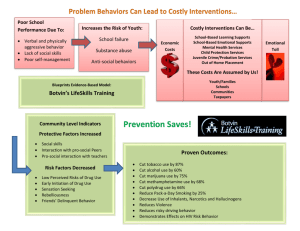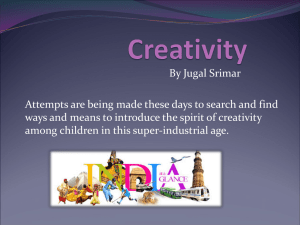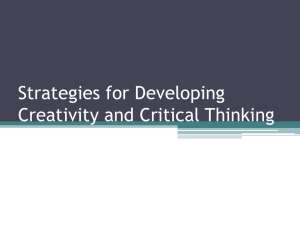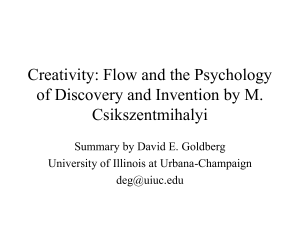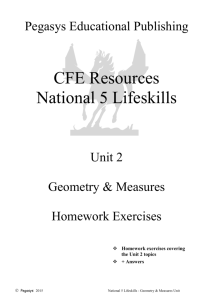lifeskills - The Center for Effective Learning
advertisement
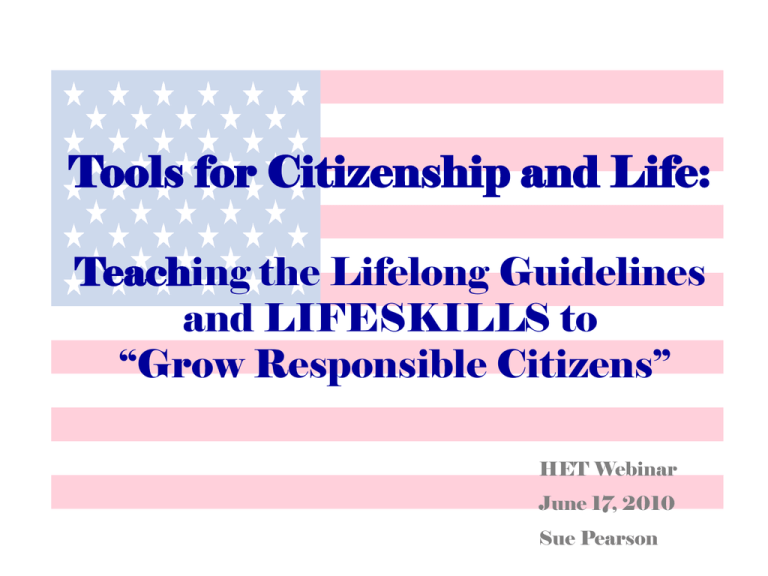
Tools for Citizenship and Life: Teaching the Lifelong Guidelines and LIFESKILLS to “Grow Responsible Citizens” HET Webinar June 17, 2010 Sue Pearson IMPLEMENTING THE LG/LS LONE RANGER TEAM One teacher ~ One class Grade level Loop group COOL SCHOOL DECISIVE DISTRICT Whole school implementation Entire community participates of LG/LS Why These? The Lifelong Guidelines were selected based on the behaviors one wants in a spouse, child, co-worker, neighbor & fellow citizen. Lifelong Guidelines and LIFESKILLS are the cultural parameters and expected behaviors for students AND adults in an HET school/classroom LIFELONG GUIDELINES Trustworthiness: To act in a manner that makes one worthy of confidence Truthfulness: To act with personal responsibility and mental accountability Active Listening: To listen with attention and intention No Put-Downs: To never use words, actions and/or body language that degrade, humiliate, or dishonor others Personal Best: To do one’s best given the circumstances and available resources Personal Best is defined by 19 LIFESKILLS LIFESKILLS •INTEGRITY: To act according to what’s right and wrong •INITIATIVE: To do something because it needs to be done •FLEXIBILITY: The ability to alter plans when necessary •PERSEVERANCE: To keep at it © Exceeding Expectations by Susan Kovalik & Karen D. Olsen, p. 9.13 LIFESKILLS •ORGANIZATION: To work in an orderly way •COOPERATION: To work together toward a common goal or purpose •PROBLEM SOLVING: To seek solutions •PATIENCE: To wait calmly © Exceeding Expectations by Susan Kovalik & Karen D. Olsen, p. 9.13 LIFESKILLS •SENSE OF HUMOR: To laugh and be playful without hurting others •EFFORT: To do your best •COMMON SENSE: To think it through •CURIOSITY: To investigate and seek understanding of one’s world © Exceeding Expectations by Susan Kovalik & Karen D. Olsen, p. 9.13 LIFESKILLS •RESPONSIBILITY: To do what’s right •CARING: To show/feel concern •COURAGE: To act according to one’s beliefs •PRIDE: Satisfaction from doing your personal best © Exceeding Expectations by Susan Kovalik & Karen D. Olsen, p. 9.13 LIFESKILLS •CREATIVITY: To think outside the box •RESOURCEFULNESS: To respond to challenges in creative ways •FRIENDSHIP: To make and keep a friend through mutual trust and caring © Exceeding Expectations by Susan Kovalik & Karen D. Olsen, p. 9.13 IT’S STANDARD PRACTICE! • • • • • • What are the Roles of the Citizen in American Democracy? What does it mean to be a citizen of the United States? How does a person become a citizen? What are important rights in the United States? What are important responsibilities of Americans? What dispositions or traits of character are important to the preservation and improvement of American democracy? • How can Americans participate in their government? • What is the importance of political leadership and public service? • How should Americans select leaders? STANDARDS~NSS-C.K-12.7 CREATIVITY WHY SHOULD A RESPONSIBLE CITIZEN PRACTICE CREATIVITY? • Problem-solving strategies are needed everywherein the home, on the job, while at play, with friends, neighbors and strangers. Being creative helps to find a variety of ways to problem-solve. • Our government needs help from its citizens in order to plan, develop, make changes, follow-through, deliver and prepare for the present, as well as the future. We can help by thinking of a variety of solutions to common/uncommon plights and problems. (e,g, oil spill in Gulf) HET ACTION PLAN GROWING RESPONSIBLE CITIZENS • • • • • Definition What it is . . . What it’s not . . . Why practice . . .? How do you practice? • What does it look like in real life? • What does it look like in school? • How do I practice. . .? • Signs of success. • Signs that more practice is needed. . . • Curriculum Connections • Home Connections IN A NUTSHELL DEFINE/ USE IN CLASS LIFE LINGO T-CHART MUSIC REAL WORLD CONNECTIONS SCHOOL CONNECTIONS LITERATURE ROLE PLAYING/ SKITS VIDEO/DVD CLIPS PROJECTS/ INQUIRIES COMMUNITY OUTREACH CREATIVITY To generate ideas; to create something original or redesign through imaginative skill CREATIVITY CREATIVITY~T-Chart Looks Like Sounds Like Feels Like Something new and different “WOW! That will solve our problem!” Praise-I can be a problem solver! Unique solution and/or product “That’s perfect! You are so creative!” Self-fullfillment CREATIVITY ~ T-Chart Does not look like Something copied from someone else Does not sound like “That’s a dumb idea! Been there, done that!” Does not feel like Being a worthwhile person with good ideas Thinking Outside the Box HOW TO PRACTICE CREATIVITY • Generate a wealth of ideas • Keep an open mind-don’t be judgmental! • Learn to use mindmapping (Inspiration, PowerPoint, http://bubbl.us • Try outlandish ideas • Learn about other creative people • Think outside the box! • Remain optimistic! CREATIVITY PRACTICE Without letting your pencil leave the paper, can you draw four straight lines through the following nine dots? TOWN HALL MEETINGS • Hold Town Hall Meetings as needed but definitely one a day at the beginning of the school year. • Provide an arena for teaching/practicing the LG/LS. • Develop an understanding of self-who I am as a person as compared to who I could be! • Build community-a safety net for practicing the LG/LS • Develop collaboration skills • Provide community outreach projects “WHERE IN THE WORLD?” BOARD • Map of the world • STEWARDSHIP: a responsibility to take care of something one does not own • LEADERSHIP: An attitude which influences, motivates, and enables others to contribute toward the effectiveness, success, and engagement of others thus creating sustainability through example. • CITIZENSHIP: Working towards the betterment of a community in which one lives through participation, volunteer work and efforts to improve the lives of all. • Identify people/places where LG/LS are being used. NEWS FLASH! We have taken the word “life” from Lifelong Guidelines and LIFESKILLS and combined it with “lingo” (the specialized vocabulary of a particular field or discipline) to form a new way to recognize use of the LG/LS. Say hello to “Life Lingo”! “Life Lingo” in 3 Steps • Say the student’s name “Deshawn, . . .” • Identify the “life” action he is using. “Desahwn, you are using creativity when you. . .” • Note the action that is taking place. “Deshawn, you are being creative! You found a unique answer to solve the problem your group was having on the project.” CREATIVITY KEY POINT Creativity is thinking of new ideas, finding unique ways to do or make things, and solving problems. (K-2) CREATIVITY KEY POINT Being creative involves being an innovative thinker, a unique problem-solver and a producer of new processes/products. (3-5) CREATIVITY KEY POINT Creative thinking involves imagining familiar things in a new light, digging below the surface to find previously undetected patterns, and finding connections among unrelated phenomena. (6-8) CREATIVITY~KEY POINT Creativity is an essential capacity for success for everyone—so essential that one could even say that it’s the non-violent means of survival. Whether in a family, classroom, business (sole proprietorship, partnership, or global mega corporation), community, or nation, creativity is the basis of survival and ability to thrive. (9-12) CREATIVITY INQUIRIES K-3 • Choose five items from the scrap box. Design a tool that will help your teacher in the classroom. Draw a picture of it and label any parts. Share you creative idea with a partner. Listen as your partner explains her tool. Give them to the teacher to try. (BK, VL, ML, S) K-3 • Listen to the book Where the Wild Things Are. Use your imagination to draw a “wild thing”. Give it a name and write two actions it takes. With a partner, share drawings, sentences and actions your “wild thing” does. Add your page to the “Wild Thing” class book. (S, VL, BK, N, ML) CREATIVITY INQUIRIES 4-8 • Enter the LEGO Smart contest. Follow the rules. Explain your entry to someone else who is entering. Ask for feedback. Offer to give feedback to this partner. Send your creation into the LEGO company for judging. Share any responses/awards your receive with your group. (LM, S, VL) Creativity Inquiries 4-12 • Go to: http://surfaquarium.com/MI/inventory.htm. Take the MI inventory. Determine where your creativity is most developed at this time. Select one MI to develop further and identify 5 ways you can do that. Select the best inquiry to build that MI and complete it. Share your accomplishment with a partner. (VL, ML, N) LIFESKILLS in SCIENCE • Used by great scientists (e.g., Albert Einstein, George Washington Carver). • Study the known and to discover the unknown. • Doing scientific experiments and in using laboratory materials/equipment. • Find solutions to problems or answers to scientific questions. • Think of new and unusual solutions/products. LIFESKILLS in SOCIAL STUDIES • • • • • Solve social problems. Resolve conflicts. Enact legislation. Use/non-use by elected officials/public figures. Could change outcome of momentous events – Gulf oil spill (responsibility/common sense/creativity). • Stand up for one’s civil rights and for one’s beliefs. LIFESKILLS in LITERATURE • Stone Fox-John Gardner • Charlotte’s Web-E.B. White • My Side of the Mountain-Jean Criaghead George • The Outsiders-S.E. Hinton • Biographies APPLICATION of LG/LIFESKILLS • Cards-Mother’s Day, Father’s Day • Contests-McDonalds/Lego/Robotics • Notes of Appreciation • Business cards NON-USE of LG/LIFESKILLS • Demonstrate the LG/LS in several ways • Reflection journal • Create/Monitor personal plan • Design posters-use photo of child on one that is difficult for him/her • Actions (verbs) posted on desk ORGANIZING YOUR SOUL YEAR WEEK TODAY CARING NEWSPAPER ARTICLES 11 Year old Olivia Bouler-NY • raised an estimated $80,000 by sending her sketches and paintings of birds to people who donate to organizations helping with relief efforts in the Gulf of Mexico spill disaster. INITIATIVE EFFORT PROBLEM SOLVING CARING RESPONSIBILITY NEWSPAPER ARTICLES 8 year old NJ boy saves 5 year old from drowning! CARING RESPONSIBILITY EFFORT COMMON SENSE FRIENDSHIP COURAGE FRIENDSHIP Actions speak louder than words! you count me “You can count on me.” CREATIVITY KILLERS! FEAR: When the child's world is chaotic or when he is afraid, he will not like novelty. He will seek the familiar, staying in his comfort zone, unwilling to leave and explore new things. DISAPPROVAL: “That’s a dumb idea! That will never work! Don’t take that apart. Don’t get dirty. Don’t! Don’t! Don’t!" Children sense and respond to our fears, biases, and attitudes. ABSENCE: The absence of a caring, invested adult removes two things essential for optimal exploration: a sense of safety and the capacity to share. HOME CONNECTIONS •Send letter home naming the current LG/LS being studied. •Offer suggestions for teaching/reinforcing this LG/LIFESKILL in real life. •Invite parents to send examples of their child using the LG/LIFESKILLS •Ask parents to model this LG/LS and to point it out when in use. COMMUNITY CONNECTIONS •Submit articles about “Growing respnsible Citizens” to your local newspapers/TV stations. •Invite community members to share their stories with students •Post LG/LS posters in local places (library, grocery stores, houses of worship, hospitals, etc. LEGO Creativity Contest • Lego education has something free to offer 10,000 new contestants for its 2010 LEGO Smart Creativity Contest • The contest requires a LEGO Smart kit and free kits are now available to the first 10,000 NEW, registered and qualified contestants. • If you're a teacher, home educator, after-school program director or otherwise working with K-12 students in the education field, register at: http://tinyurl.com/39vt92y CREATIVITY RESOURCES http://bensguide.gpo.gov/ US Government Web Sites-Kids http://bensguide.gpo.gov/subject.html • • • • • • • • • Animals Agriculture Arts/Recreation Business/Money Careers Communities/People Computers/Internet Crime & Justice Transportation • • • • • • • • • Education Environment Foreign Affairs Geography Government & Law Health & Safety History Science Defense/National Security WEBSITE: Learning to Give EDUCATES youth about philanthropy, the civil society sector, and the importance of giving their time, talent and treasure for the common good (knowledge), DEVELOPS philanthropic behavior and experience (skills), and, EMPOWERS youth to take voluntary citizen action for the common good in their classrooms, their lives and their communities (behavior). http://www.learningtogive.org/ CREATIVITY Without letting your pencil leave the paper, can you draw four straight lines through the following nine dots? "Never doubt that a small group of thoughtful, committed citizens can change the world; indeed, it's the only thing that ever has." Margaret Mead, cultural anthropologist HET RESOURCES http://www.books4educ.com/lifeskills.htm LG/LIFESKILLS RESOURCES http://www.books4educ.com/lifeskills.htm LG/LIFESKILLS RESOURCES http://www.books4educ.com/lifeskills.htm LG/LIFESKILLS RESOURCES Barbara Lewis ~ www.freespirit.com Integrating the Arts Our Next Webinar July 15, 2010 Sign-up at the website www.thecenter4learning.com The Center for Effective Learning To inquire about our services and the Highly Effective Teaching Model visit our website or call Deb Schweikl at our corporate office: (253) 815-8800. http://thecenter4learning.com/
